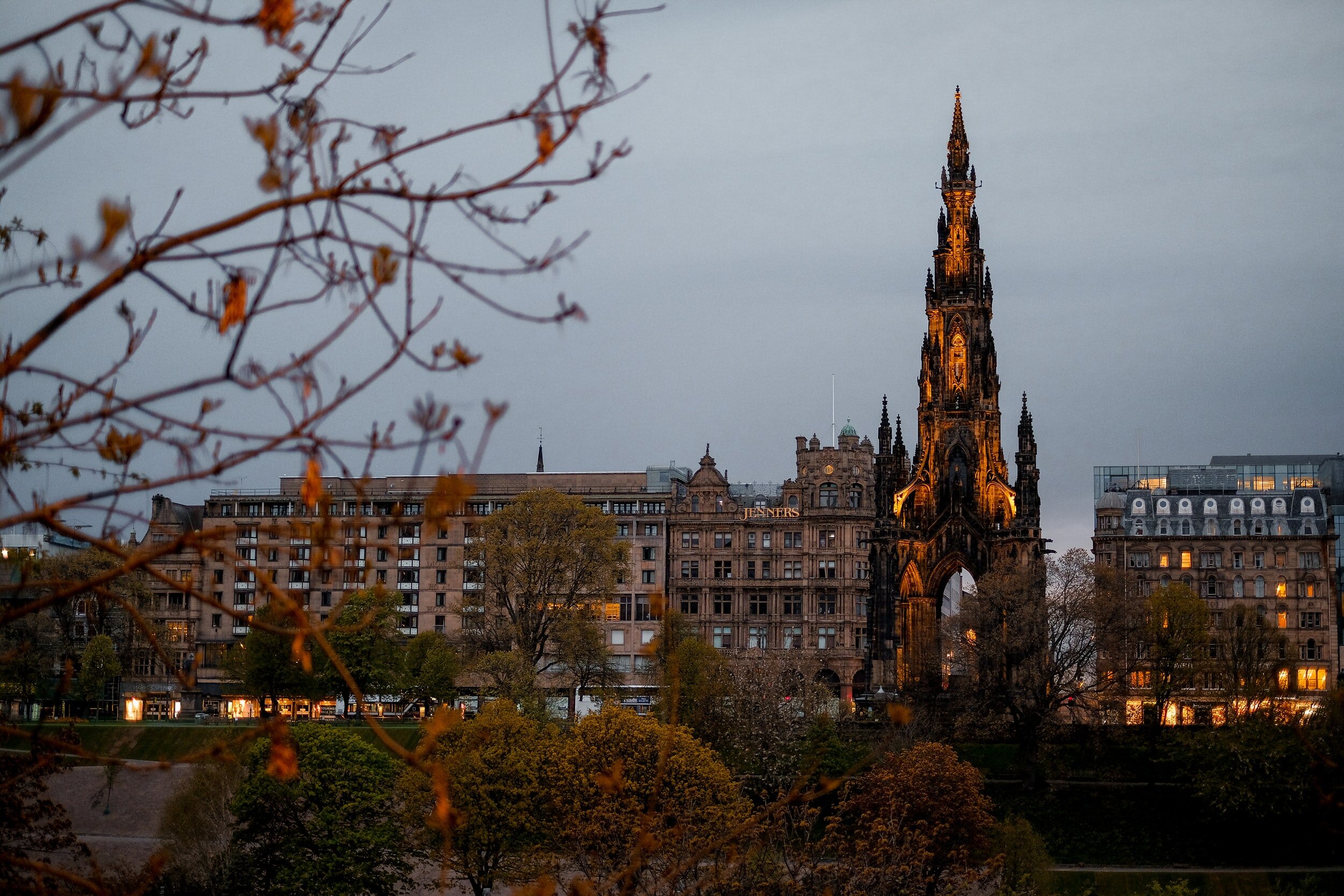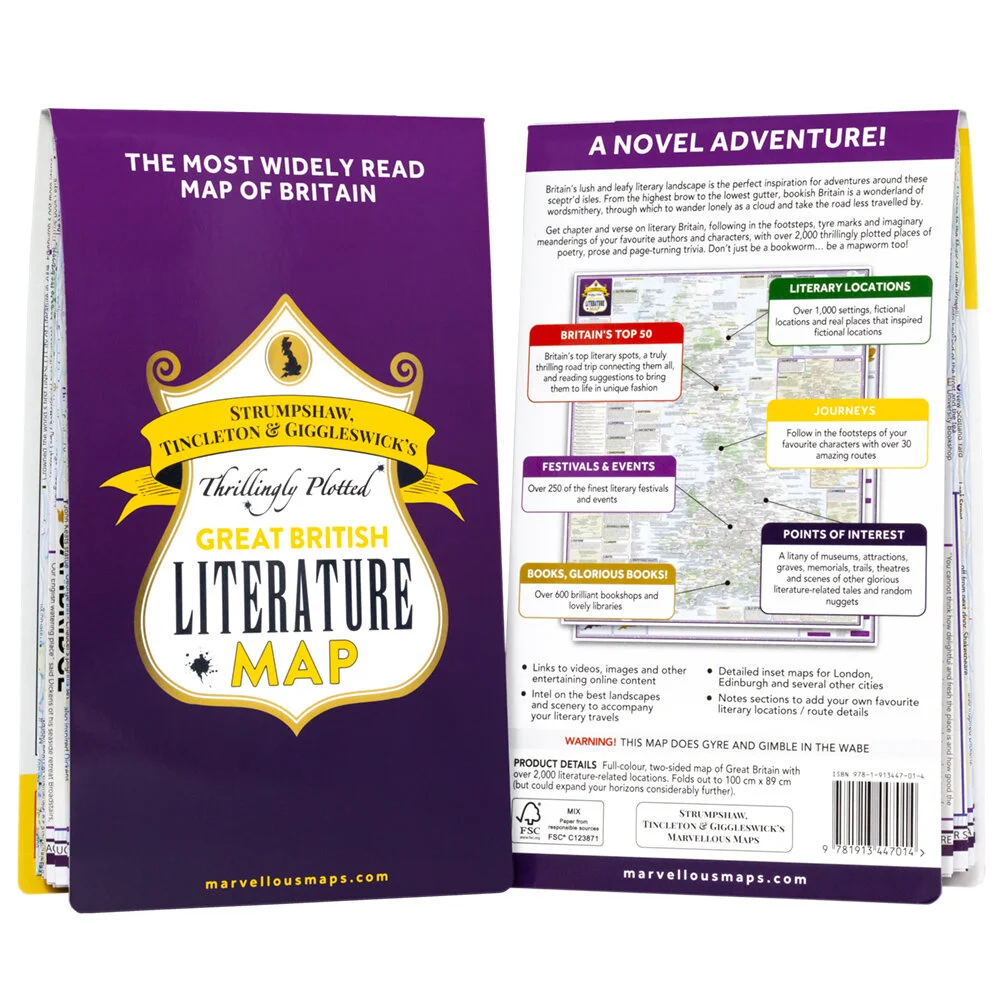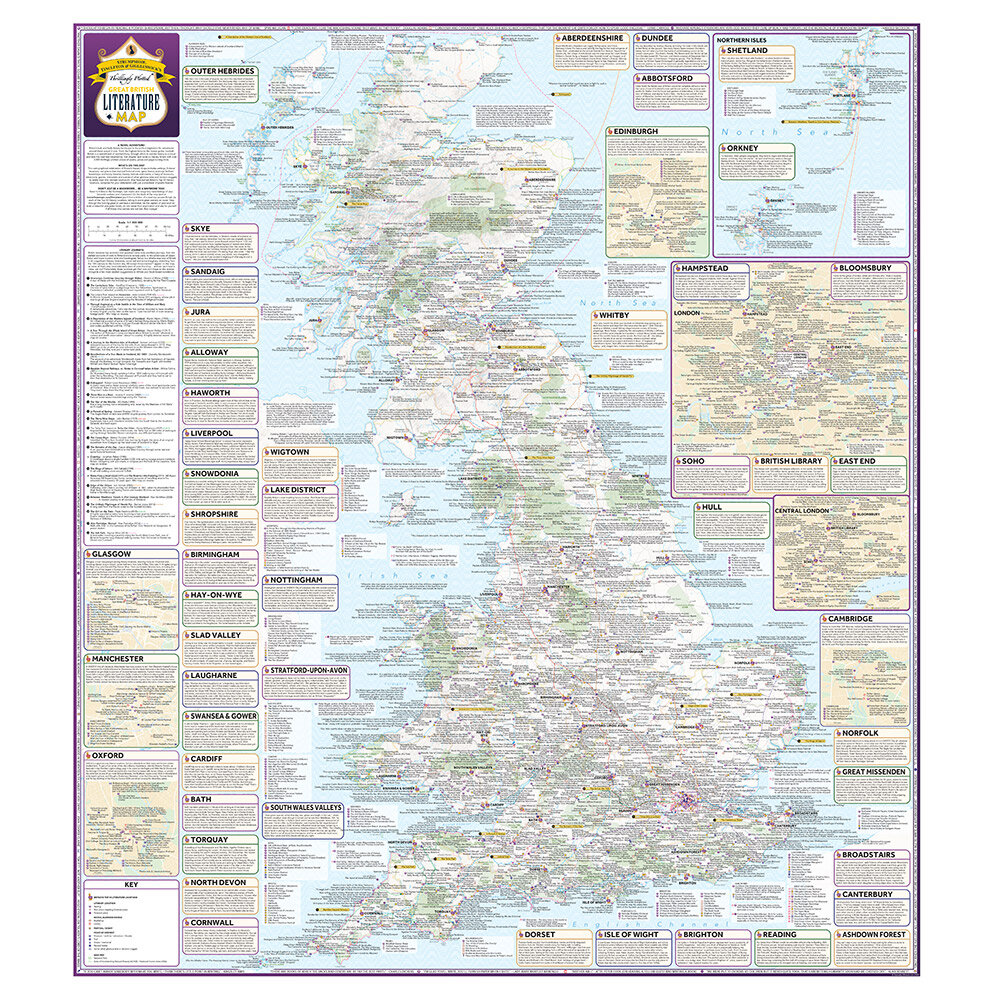Explore Britain’s Literary Locations
Britain’s lush and leafy literary landscape is the perfect inspiration for adventures around these sceptr’d isles. From the highest brow to the lowest gutter, bookish Britain is a wonderland of wordsmithery, through which to wander lonely as a cloud and take the road less travelled by.
Looking to take your bookwormery to new levels? There’s more literary largesse to be found on our Thrillingly Plotted Great British Literature Map - available in 3 formats (fold-out, flat or framed) from £14.99.
Britain's Top 12 Literary Locations
Bloomsbury
Home to the group of writers, artists and thinkers who "lived in squares, painted in circles and loved in triangles", Bloomsbury is a distinguished part of town. Visit the British Museum, whose collections inspired 'Ode on a Grecian Urn' by Keats and whose iconic Reading Room in the courtyard is where writers including Conan Doyle, Stoker and Lodge used to read and write. Wander past Senate House, inspiration for Orwell's Ministry of Truth in Nineteen Eighty-Four and, to shake off the feeling that Big Brother is watching, take a breather in one of Bloomsbury's elegant squares to read and dream, perhaps by Virginia Woolf's statue in Tavistock Place.
Brighton
For Lydia in Pride & Prejudice Brighton represented "every possibility of earthly happiness," but when you think of Brighton in literature, Keith Waterhouse's description of "a town that is perpetually helping the police with their inquiries" is perhaps closer to the mark. From Graham Greene's infamous Brighton Rock, via Nick Cave's The Death of Bunny Munro, to the detective novels of Peter James and Elly Griffiths, Brighton has a seedier side to discover. The perfect place for an illicit weekend, a murder or a dodgy deal, Noel Coward's Brighton of "piers, queers and racketeers" has inspired us for years.
Bath
Bath has been celebrated in literature for as long as it has been a spa town, and famous visitors who have written about the society scene and taking the waters here include Samuel Pepys, Mary Shelley and Charles Dickens. Regency play The Rivals, by Sheridan, was set here, and today Bath boasts Europe's biggest children's literature festival, as well as one big excuse for ridiculous fancy dress, the Regency Costumed Ball (part of the annual Jane Austen Festival). Austen reputedly did not enjoy Bath, with its 'stupid parties', but the beautiful city features prominently in the Austen landscape, appearing in both Northanger Abbey and Persuasion.
Edinburgh
Crowned the world's first UNESCO City of Literature in 2004, Edinburgh's got more literary connections than you can waft a magic wand at. Start at the Writer's Museum to get your bearings, browse in the wondrous libraries and book shops, catch the latest literati at the Edinburgh Book Festival, then stalk the streets that have inspired writers from Stevenson to Spark, Rowling to Rankin, Welsh to Sir Walter. Talking of whom, Edinburgh boasts the tallest monument to a writer in the world, the Scott Monument, and the only railway station to be named after a novel: Sir Walter's Waverley. To bring you back down to earth, have a drink at Milne's bar, the 'poets' pub'.
Alloway
Robert Burns, Scotland's National Bard, was born in Alloway, Ayrshire, in 1759 and lives on in a way that possibly no other writer, anywhere, has, does or will. Celebrate Burns Night on 25th January each year, address a haggis ("great chieftain o' the puddin-race!") and see where the Ploughman Poet lived and got his inspiration from on the Burns Heritage Trail around the south west of Scotland, including Burns Cottage / Birthplace Museum, Ellisland Farm where he wrote 'Auld Lang Syne', and the Robert Burns House in Dumfries. He spent much of his later life there, mainly "making ballads, and then drinking and singing them".
Aberdeenshire
Stuart MacBride's Aberdeen-set Logan McRae series and Claire MacLeary's local PIs Harcus and Laird fly the flag for the local subgenre of 'Tartan Noir', celebrated at the annual Granite Noir festival. Beyond the granite city, the village of Arbuthnott was the inspiration for Lewis Grassic Gibbon's Sunset Song, a frequent 'best Scottish novel' poll-topper, and on the coast, Slains Castle helped inspire Bram Stoker's Dracula. Moving inland, another key Aberdonian literary figure is Nan Shepherd, whose love for the Cairngorms shines through The Living Mountain, continually inspiring visitors to Britain's biggest national park.
Hay-on-Wye
"Is that a sandwich?" Arthur Miller apparently asked about Hay-on-Wye, whose world-famous book festival is known as the 'Woodstock of the mind'. Hay became a book town after local Richard Booth set up his first bookshop in 1962, and now there are more than 20 bookshops for the 1600 residents, and hundreds of thousands of festival goers to not one but two literary festivals. For maximum literary points, stay at the Baskerville Hotel in nearby Clyro - the name inspired Conan Doyle's spooky hound. Fun fact: in 1977 Booth was crowned King Of Hay, a newly independent kingdom, and then handed out titles to his neighbours. His horse became prime minister.
SANDAIG
“I sit in a pitch-pine panelled kitchen-living room, with an otter asleep upon its back among the cushions on the sofa, forepaws in the air." So begins Ring of Bright Water, Gavin Maxwell's tale of living in an isolated cottage with his otters Midjil, then Edal, in the 1950s. The cottage eventually burnt down, but you can find the cairns where Maxwell's ashes and the body of Edal are buried here, as well as the bright water itself, in the bay of this glorious stretch of Scottish coastline. The phrase comes from the poem 'The Marriage of Psyche' by Kathleen Raine, who tells her side of the story in her memoir, The Lion's Mouth.
Haworth
Born in Thornton, the Brontë siblings spent most of their (short) lives at the parsonage in Haworth, and the latter is now a museum dedicated to them. From Haworth you can pick up the Brontë Way and visit many of the places that inspired Charlotte, Emily and Anne and their famous novels including Top Withens, supposedly the model for the Earnshaw's house in Wuthering Heights, Oakwell Hall (Fieldhead in Shirley) and Ponden Hall which could be the model for Thornfield Hall. Along the way there is Brontë waterfall, Bronte Bridge, their graves in the churchyard and many plaques dedicated to the family. A must for Brontë fans, no matter which sister is your fave.
Swansea & Gower
A visit to Dylan Thomas's “ugly lovely town” should take in his childhood home (now a museum) and the Kardomah Cafe (relocated), where Swansea's most famous son and his pals met to talk about "music and poetry and painting and politics, Einstein and Epstein, Stravinsky and Greta Garbo, death and religion, Picasso and girls." Swansea also gave us Amy Dillwyn, whose novel The Rebecca Rioter was inspired by the true story of Welsh protesters dressed as women in the 1840s, and Joe Dunthorne, whose debut novel Submarine is set in Swansea. His second, Wild Abandon, is set in the beautiful Gower peninsula, where Thomas once got stranded overnight, on the Worm's Head. Eek.
Stratford-upon-avon
"This King Shakespeare, does not he shine, in crowned sovereignty, over us all, as the noblest, gentlest, yet strongest of rallying signs; indestructible" said Thomas Carlyle in 1840. Or as Dame Judi Dench called him: "the gentleman who pays the rent". Take in Shakespeare's birthplace, school, wife's house, mother's house, daughter's house and grave in and around town, before popping in to the RSC to catch some of his words in action. You will be in illustrious company, as Charles Dickens, Samuel Pepys, John Keats, Walter Scott and Thomas Hardy have all signed the town's guest books. And did you know the Bard's marriage record refers to him as William 'Shagspere'?
Lake District
Possibly Britain's most inspiring literary location. Find those famous golden daffodils and your own inspiration in the Lake District, where William Wordsworth (or Turdsworth, as Lord Byron reputedly called him) lived for several years. You can visit not one but two houses with Wordsworth links, as well as the museum and archive in his honour, near Grasmere. For fans of children's books, the Lake District is where most of the Swallows and Amazons series was set (Arthur Ransome lived near Coniston), and where Beatrix Potter, creator of Peter Rabbit, Jemima Puddle-Duck and friends, lived. Her house, Hill Top, is here and visitable.
WOOOOOOORD TRIP!
Hit the road on a British literature-themed adventure, picture yourself in your favourite scenes and admire the finest scenery in the land as you go. Here you can download a map of Britain’s top 50 literature locations, all of them connected by a rather ambitious road trip…
Get The Map
All the literary largesse on this page is drawn from the Thrillingly Plotted Great British Literature Map. Available in 3 formats (fold-out, flat or framed) from £14.99. If you’ve got the map and have any feedback or suggestions for the next edition, we’d love to hear from you - email us at hello@marvellousmaps.com.







